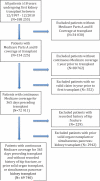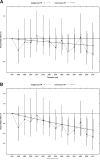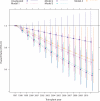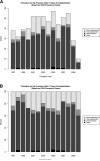Temporal trends in the incidence, treatment and outcomes of hip fracture after first kidney transplantation in the United States
- PMID: 24712332
- PMCID: PMC4117735
- DOI: 10.1111/ajt.12652
Temporal trends in the incidence, treatment and outcomes of hip fracture after first kidney transplantation in the United States
Abstract
It is currently unknown whether any secular trends exist in the incidence and outcomes of hip fracture in kidney transplant recipients (KTR). We identified first-time KTR (1997-2010) who had >1 year of Medicare coverage and no recorded history of hip fracture. New hip fractures were identified from corresponding diagnosis and surgical procedure codes. Outcomes studied included time to hip fracture, type of surgery received and 30-day mortality. Of 69,740 KTR transplanted in 1997-2010, 597 experienced a hip fracture event during 155,341 person-years of follow-up for an incidence rate of 3.8 per 1000 person-years. While unadjusted hip fracture incidence did not change, strong confounding by case mix was present. Using year of transplantation as a continuous variable, the hazard ratio (HR) for hip fracture in 2010 compared with 1997, adjusted for demographic, dialysis, comorbid and most transplant-related factors, was 0.56 (95% confidence interval [CI]: 0.41-0.77). Adjusting for baseline immunosuppression modestly attenuated the HR (0.68; 95% CI: 0.47-0.99). The 30-day mortality was 2.2 (95% CI: 1.3-3.7) per 100 events. In summary, hip fractures remain an important complication after kidney transplantation. Since 1997, case-mix adjusted posttransplant hip fracture rates have declined substantially. Changes in immunosuppressive therapy appear to be partly responsible for these favorable findings.
Keywords: Bone disease; fracture; kidney transplant; mortality; outcomes.
© Copyright 2014 The American Society of Transplantation and the American Society of Transplant Surgeons.
Figures





References
-
- Braithwaite RS, Col NF, Wong JB. Estimating hip fracture morbidity, mortality and costs. J Am Geriatr Soc. 2003;51:364–370. - PubMed
-
- Alem AM, Sherrard DJ, Gillen DL, et al. Increased risk of hip fracture among patients with end-stage renal disease. Kidney Int. 2000;58:396–399. - PubMed
-
- Ball AM, Gillen DL, Sherrard D, et al. Risk of hip fracture among dialysis and renal transplant recipients. JAMA. 2002;288:3014–3018. - PubMed
-
- Weisinger JR, Carlini RG, Rojas E, Bellorin-Font E. Bone disease after renal transplantation. Clin J Am Soc Nephrol. 2006;1:1300–1313. - PubMed
-
- Alshayeb HM, Josephson MA, Sprague SM. CKD-mineral and bone disorder management in kidney transplant recipients. Am J Kidney Dis. 2013;61:310–325. - PubMed
Publication types
MeSH terms
Grants and funding
LinkOut - more resources
Full Text Sources
Other Literature Sources
Medical

